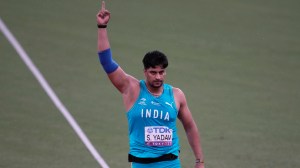TV replays: Flannelled fools should not rush in
Okay, was the technology lark at the ICC Champions Trophy event a success or a failure? Did it improve the standard of decision-making and, ...

Okay, was the technology lark at the ICC Champions Trophy event a success or a failure? Did it improve the standard of decision-making and, if so, is it going to be used at the World Cup five months from now?
What has emerged from the end of tournament deliberations is that the International Cricket Council are not going to make a firm decision just yet. There is a little too much to chew over and technology is one area where they are not going to be rushed in making a decision by outside influences. This, it seems, includes the 2003 Cricket World Cup committee headed by Dr Ali Bacher, the former South African cricket chief who now heads the CWC operations in Johannesburg. He was in the Sri Lankan capital during the tournament outlining some of plans for the event.
The ICC’s cricket committee and the cricket management committee are those in charge of the process of making a decision on the new umpiring technology; they will make the final recommendation. This of course is not going to sit too well with some studio TV anchormen who give the impression they know it all. There are those who have already said they want it extended without a broader examination of the mechanics of what is a complicated system.
Mark Harrison, the ICC’s communications manager, gave a detailed outline of how the process works and, without giving a time limit, suggested it may take ‘‘some time before a decision is reached’’. When the list of those involved and the channels it has to go through are considered, a rushed job could mean a botched job and that is where the problem area arises. The ICC do not want a smudged issue over this considerable matter; just too much is involved.
One example of not calling on the TV umpire for a referral was when Steve Bucknor ignored a near confrontational appeal from Sri Lanka’s Chaminda Vaas during Monday night’s replayed final. The batsman was Sachin Tendulkar and while the TV replays may have suggested one thing, Bucknor stood his ground. He was not about to become a robot because of one appeal.
There were times during the tournament when some referrals for lbw and caught-behind were surprising, and there were a couple which were wrongly given; the catch off Brian Lara in the pool match between the West Indies and Kenya. At the time the left-hander was on 32. The appeal went in favour of Lara, yet several replays gave the distinct impression of some deviation into the wicketkeeper’s gloves. Lara went on to score 111 and then landed in hospital en route back home with suspected hepatitis, missing the tour of India. If the referral system is to be considered on the current merits of the ICC Champions Trophy, which saw an average of four referrals a match and the time spent was a minute or less over each decision, it was not so difficult. ‘‘It did not mean long delays and the feeling is that in this sense it did work as it did not take too much time out of a game’’, Harrison said.
‘‘What has to be done now is for the those responsible to sit down and go through the referral process and how successful it was’’, he added. ‘‘This means looking at the tapes and all the referral decisions; it means talking to the umpires, the match referees and the captains for a consensus of views.’’ There would also be a need to talk to the TV engineers and other technical advisors about the accuracy of the decisions and if this improved the game as well as helping the umpires in making decisions. ‘‘All involved need to be satisfied that it is the right technology and that it can be used in Tests as well as World Cup matches’’, Harrison explained. ‘‘It is so important to get it right.’’
The system has its critics. Former England captain Mike Atherton is one while another is former Test umpire Dickie Bird. One who is in favour is Ricky Ponting, Australia’s current one-day captain, who felt ‘‘It worked fine, I think it is a fine innovation’’ he said when asked for his views.
Photos



- 01
- 02
- 03
- 04
- 05




























